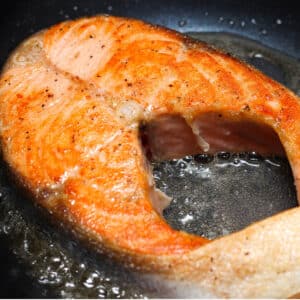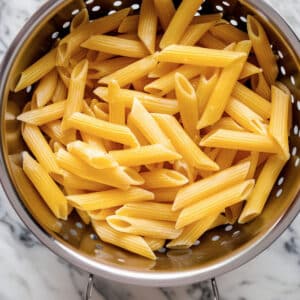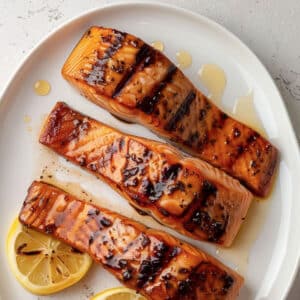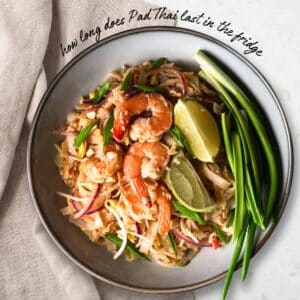Which do you prefer: Pad Thai vs Lo Mein? It's a tricky question. They both seem so delicious. But which is the better dish? Well, that depends on what you're looking for in a meal. In this post, we'll break down the differences between these two Asian cuisine favorites, so you can make an informed decision next time you're at the take-out place.
Previously, I made a post about Pad Thai vs. Pad See Ew where I went into detail about the differences between the two noodles. This time, we will explore the difference between Pad Thai and Lo Mein.
But first, a little bit about these noodles.
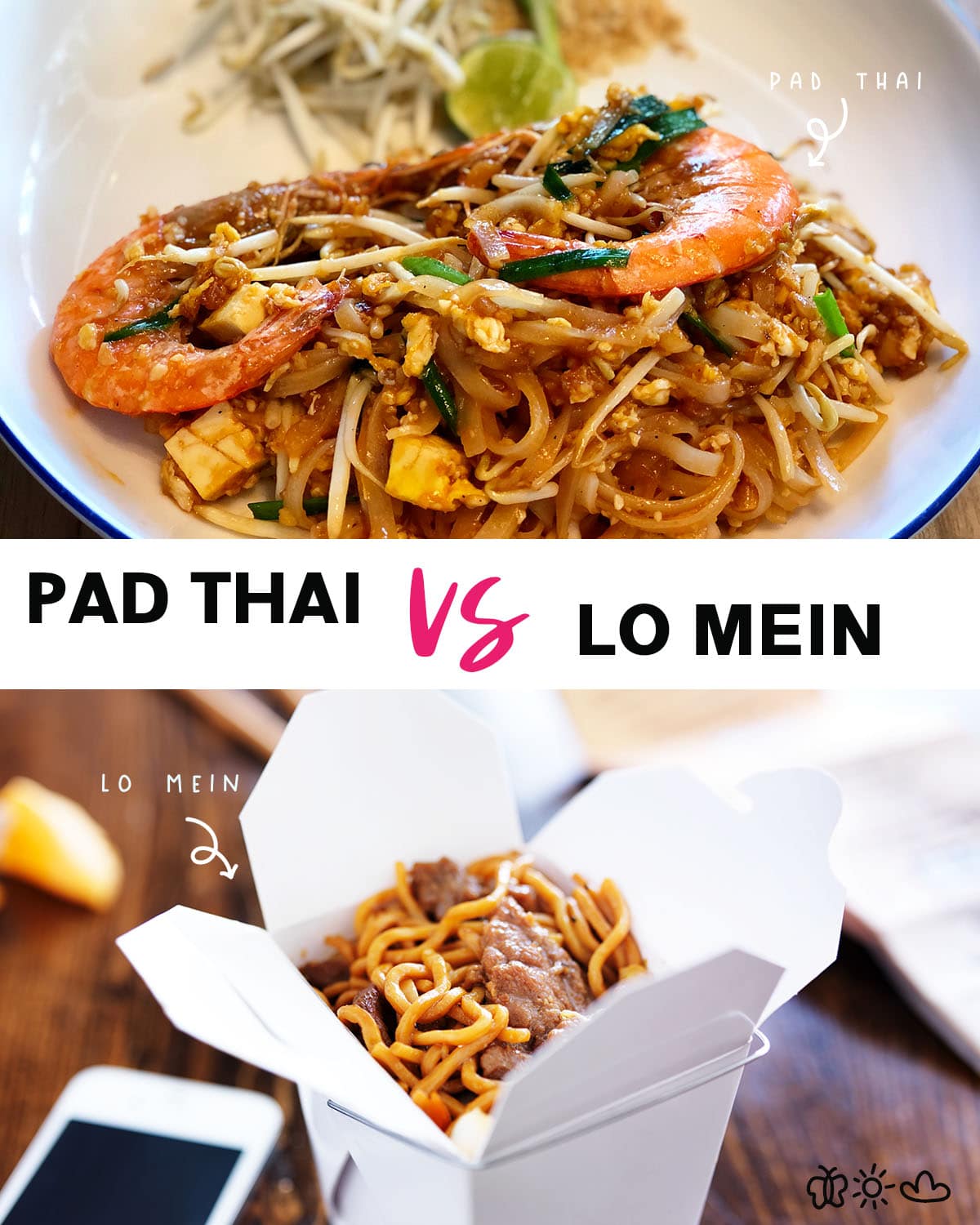
Pad Thai is a stir-fried rice noodle dish that originates in Thailand. It is made with rice noodles, chicken or shrimp, tofu, peanuts, and a tamarind sauce. On the other hand, Lo Mein is a Chinese noodle dish consisting of egg noodles, vegetables, and protein (usually chicken, pork, or shrimp). It is tossed in a sauce made of oyster sauce, soy sauce, and sesame oil.
So, what are the differences between these two dishes? Let's take a closer look.
Pad Thai vs Lo Mein - Comparison Table
You're probably thinking, "How can I choose between these two delicious noodle dishes?" If you're stuck trying to decide which one to order, use this handy guide to help you decide.
| Features | Pad Thai | Lo Mein |
|---|---|---|
| Noodles | Flat rice noodles, softer texture | Egg noodles, chewier texture |
| Protein Options | Chicken, shrimp, beef or tofu | Chicken, beef, pork, shrimp, or tofu |
| Vegetables | Bean sprouts, carrots, onions, chives | Cabbage, carrots, onions, mushrooms |
| Sauces | Tamarind sauce, Fish sauce | Oyster sauce, Soy sauce, Sesame oil |
| Taste Profile | Sweeter due to Tamarind sauce | Saltier due to Oyster and Soy sauce |
| Dish Texture | Softer noodles, noodle-heavy dish | Thicker noodles, vegetable-heavy dish |
| Aspect Ratio | Short, wide noodles | Long, thin noodles |
| Toppings | Peanuts, lime wedge | Served with a small broth, soy sauce |
| Gluten-free | Yes (if using GF sauces) | No |
| Vegetarian/Vegan Options | Yes (with sauce adjustment) | Yes (with sauce adjustment) |
1 Pad Thai ingredients include:
- Flat rice noodles: these are the noodles used in most Thai dishes. They are wide and flat and have a chewy texture.
- Protein: this can be chicken, shrimp, or tofu, often combined with eggs.
- Vegetables: these typically include bean sprouts, carrots, and onions.
- Peanuts are a typical garnish that adds a nice crunch to the dish. You can add them to your dish if you like.
- Tamarind sauce: this is what gives Pad Thai its unique sour-sweet flavor. This brownish paste is made from tamarind fruit and is widely used in Thai cooking.
- Fish sauce: this is another common ingredient in Thai cuisine. It is made from fermented fish and salt and has a strong, salty flavor.
- Pad Thai is typically served with a lime wedge and crushed peanuts on top.
Read:
Now let's take a look at the ingredients in Lo Mein.
- Egg noodles: these are the noodles most commonly used in Chinese cuisine. They are made from wheat flour and eggs and have a soft, bouncy texture.
- Protein: this can be chicken, pork, shrimp, or tofu which is stir-fried with noodles and vegetables.
- Vegetables: these can include cabbage, carrots, onions, and mushrooms.
- Oyster sauce: this is a thick, dark sauce made from oysters. Many Chinese dishes use this salty-sweet ingredient.
- Soy sauce: this is a fermented sauce made from soybeans, wheat, and salt. A salty flavor characterizes its taste.
- Sesame oil: this is a light oil made from sesame seeds. It has a nutty flavor which goes well with the other ingredients in Lo Mein.
- Lo Mein is normally served with a small amount of broth on the side and soy sauce.
Now that we've gone over the ingredients let's break down other factors that make these dishes different. This guide can help you decide which noodle dish is right for you.
2 Texture
The most significant difference between these two dishes is the texture of the noodles. Pad Thai noodles are thinner and have a softer texture, while Lo Mein noodles are thicker and have a chewier texture. Pad Thai noodles are also stir-fried, while Lo Mein noodles are boiled. If you are looking for ease of eating and different textures, this may be the right choice.
3 Aspect Ratio
Another difference between these two dishes is the aspect ratio. What is the aspect ratio? It's the width-to-height ratio of the noodles. Pad Thai noodles are cut into short, wide pieces, and Lo Mein noodles are cut into longer, thinner pieces.
This may not seem like a big deal, but it can affect how you eat the noodles. For example, if you're using chopsticks, Pad Thai may be easier to eat because the noodles are shorter. While if you're using a fork, Lo Mein may be easier to eat because the noodles are thinner.
Pad Thai is a noodle-heavy dish, while Lo Mein has a higher ratio of vegetables to noodles. So, Lo Mein may be the way to go if you're looking for a heartier meal.
4 Taste
Now, let's talk about taste. Pad Thai has a sweeter flavor because of the tamarind sauce, while Lo Mein has a saltier flavor because of the oyster sauce.
When it comes to taste, these two dishes are quite different. Pad Thai has a sweeter flavor because it contains tamarind sauce, fish sauce, and savory and sweet sugar. The combination of sweet, sour, and tangy flavors adds complexity and depth to the dish. When it comes to taste, Pad Thai is the winner.
Lo Mein, on the other hand, is a little bit one-dimensional. It's basically just noodles, protein, and vegetables tossed in a sauce. The sauce is the dominant flavor, and the other ingredients don't add much to the dish.
There's nothing wrong with that, but it doesn't have the same depth of flavor as Pad Thai. If we add sugar, it might be too sweet because the Chinese prefer a savory taste over sweet. In comparison, Lo Mein is just salty because of the soy sauce and oyster sauce.
The sweet taste of Pad Thai may be a deciding factor if you have a sweet tooth. However, the saltiness of Lo Mein may be a turn-off for some. But, the salinity can be toned by adding less oyster sauce to the dish.
5 Flavor
Another big difference between these two dishes is the flavor. Pad Thai is typically sweeter and has a tamarind-based sauce, while Lo Mein is saltier and has an oyster sauce-based sauce. If you're looking for a more flavorful and complex dish, then Pad Thai is the way to go. But if you're looking for a quick and easy meal, then Lo Mein is a good choice.
Pad Thai is a bit sweeter than Lo Mein due to the addition of tamarind sauce. It is also a lighter overall flavor, making it a good choice if you're looking for a healthier option.
You should choose Lo Mein if you want something more hearty. On the other hand, Lo Mein is richer and has a more savory flavor. This is due to the addition of oyster sauce and sesame oil.
6 The Noodles
The thickness and texture of the noodles are the two main differences between Pad Thai and Lo Mein. It can affect how you eat the noodles and the taste of the dish as a whole.
- You'll first notice that Pad Thai is made with flat rice noodles, which are thinner and have a softer texture than the round noodles used in Lo Mein. Lo Mein uses egg noodles, which are thicker and have a chewy texture.
- Secondly, Pad Thai noodles are stir-fried, while Lo Mein noodles are boiled. Lo Mein noodles have a softer texture, whereas Pad Thai noodles are slightly crispier.
- Pad Thai noodles are typically cut into shorter, wider pieces, while Lo Mein noodles are cut into longer, thinner pieces. This may not seem like a big deal, but it can affect how you eat the noodles. For example, if you're using chopsticks, Pad Thai may be easier to eat because the noodles are shorter. While if you're using a fork, Lo Mein may be easier to eat because the noodles are thinner.
Pad Thai is a noodle-heavy dish, while Lo Mein has a higher ratio of vegetables to noodles. If you prefer a heartier meal, Lo Mein may be just right for you.
7 Sauce
Another difference is in the sauce. Lo Mein is typically tossed in an oyster sauce, while Pad Thai is usually made with a tamarind-based sauce. This gives Pad Thai a sweeter taste, while Lo Mein has a more savory flavor.
Pad Thai sauce also has a richer and more complex flavor because it contains fish sauce, which is quite pungent. Lo Mein sauce is simply made with soy sauce and oyster sauce, so it doesn't have the same depth of flavor.
Another difference is in the sauce. Pad Thai uses a tamarind sauce which gives it a sour and sweet flavor. On the other hand, Lo Mein uses a sauce made of oyster sauce, soy sauce, and sesame oil. Such a sauce lends a savory taste to the dish.
8 Protein
For protein, I would recommend chicken or shrimp for Pad Thai and chicken or pork for Lo Mein. Pad Thai usually contains chicken or shrimp, while Lo Mein typically has chicken, pork, or shrimp. But you can put whatever protein you want in either dish.
When it comes to protein, you can make both dishes with chicken, shrimp, or tofu. However, Pad Thai is typically made with chicken or shrimp, while Lo Mein usually comes with chicken or pork.
9 Toppings
Finally, the toppings for these two dishes are different. Lo Mein is often topped with green onions, and Pad Thai is usually garnished with peanuts, cilantro, and lime wedges.
10 Gluten-free
How does Pad Thai be gluten-free? Pad Thai is naturally gluten-free, while Lo Mein is not. The rice noodles used in Pad Thai do not contain gluten. On the other hand, Lo Mein uses wheat-based egg noodles, which contain gluten.
Pad Thai is usually prepared with tamarind paste, which is naturally gluten-free. The sauce for Lo Mein, on the other hand, is typically made with soy sauce and oyster sauce. Depending on the brand, soy sauce does contain gluten, and oyster sauce may or may not. So, if you're looking for a completely gluten-free dish, Pad Thai is your best choice.
11 Vegetarian/vegan
Both Pad Thai and Lo Mein can be made vegetarian or vegan. To make Pad Thai vegetarian, simply omit the protein or substitute it with tofu. For a vegan version, use a tamarind-based sauce instead of the fish sauce. To make Lo Mein vegetarian, omit the meat and use extra vegetables. For a vegan version, use a soy-based sauce instead of oyster sauce.
12 Price
Regarding price, Pad Thai is usually cheaper than Lo Mein. Why is that? It's because Pad Thai is made with rice noodles cheaper than egg noodles. And, it doesn't contain as many ingredients as Lo Mein.
Pad Thai may be the way to go if you're on a budget. But, if you're willing to spend a little extra, Lo Mein is worth the price. However, the price difference may not be significant enough to be a deciding factor.
So, there you have it! A comparison of Pad Thai vs. Lo Mein.
Read:
Which one is healthier, Pad Thai or Lo Mein?
These delivery staples may seem similar, but the Pad Thai vs Lo Mein debate is real. We break down the nutrition of both dishes to see which is healthier for you.
In the world of takeaway food, few options are more popular than Chinese food – and within that cuisine, lo mein and pad thai reign supreme. But what is the difference between these two fan favorites? And more importantly, which one is better for you?
The preparation makes all the difference when it comes to these two dishes. A lo mein dish loaded with vegetables and lean protein can be healthier than a greasy pad thai with processed meats.
However, if you're comparing two similar dishes, pad thai is typically the healthier option since it generally contains fewer calories and less fat. Lo Mein is often high in sodium, while Pad Thai has a lower sodium content.
Pad Thai vs Lo Mein calories:
To answer these pressing questions, we've compared the nutrition of lo mein vs pad thai, so you can make an informed decision next time you're ordering in. According to the USDA, these are the average nutrition facts for 0.5 packaged (340 g) of Lo Mein and pre-packaged Pad Thai.
Lo Mein
Nutritional values vary depending on the portion size and ingredients. A 0.5 package (340 g) with shrimps yields the following nutrients according to FDC.nal.usda.gov.
- Calories: 428 calories
- Fat: 16 g
- Saturated fat: 2.1 g
- Cholesterol: 0 mg
- Sodium: 989 mg
- Carbohydrates: 57 g
- Fiber: 6.12 g
- Sugar: 7 g
- Protein: 22 g
Is Lo Mein healthy?
This iconic Chinese staple is a dietary equivalent of a blank canvas – it can be as healthy or unhealthy as you make it. Vegetables and lean protein can make a dish healthier than one laden with sodium and saturated fat.
The noodles are usually made from wheat flour and egg, so they contain gluten. Also, Lo Mein comes in an oil-drenched sauce, which can add unhealthy fats and calories to the dish. The sodium content in Lo Mein can also be relatively high, so if you're watching your salt intake, this is also something to keep in mind.
The downside of eating Lo Mein
You should be aware of two points when eating Lo Mein. While Lo Mein can be a healthy option, it's also important to be mindful of the potential downsides. As we mentioned, noodles are commonly made from wheat flour and eggs, and gluten is present in them.
1 High in Carbs
This mound of noodles is relatively high in carbs, which isn't ideal if you're trying to minimize your carb intake. One half-package of Lo Mein contains 57 grams of carbs, which is about 20% of the daily recommended intake for carbs (for someone eating 2,000 calories per day).
2 Can Be High in Sodium
Lo Mein can also be high in sodium, which is something to watch out for if you're trying to limit your salt intake. A half-package of Lo Mein contains 989 mg of sodium, about 41% of the daily recommended intake for sodium (for someone eating 2,000 calories per day).
Why is Lo Mein high in sodium?
Due to its soy sauce base, lo mein has a high sodium content. Aside from that, Lo Mein is also often made with other high-sodium ingredients like oyster sauce, hoisin sauce, and fish sauce.
Another point is that Lo Mein comes in an oil-drenched sauce, which can add unhealthy fats and calories to the dish.
Pad Thai
Nutritional values will vary depending on the ingredients used and the portion size, but typically, a pre-packaged Pad Thai (311 g) with white chicken meat provides the following nutrients according to USDA.gov
- Calories: 429 calories
- Fat: 2.49 grams
- Saturated fat: 2.5 grams
- Cholesterol: 40.4 milligrams
- Sodium: 659 milligrams
- Carbohydrates: 82 grams
- Fiber: 4.04 grams
- Sugar: 23 grams
- Protein: 20 grams
Downsides of eating Pad Thai
While Pad Thai is typically the healthier option, it's important to note that it can still be high in calories and sodium. There are two points to consider when you're eating Pad Thai.
1 Pad Thai is also relatively high in sodium
While the American Heart Association (AHA) recommends that adults consume no more than 2,300 milligrams of sodium per day, one serving of pad thai can have up to 790 milligrams — almost one-third of the AHA's limit.
Why is Pad Thai high in sodium?
The high sodium content in pad thai is due to the addition of fish sauce made with anchovies, salt, and water. Fish sauce is a staple ingredient in many Southeast Asian dishes and gives pad thai its characteristic salty flavor.
While you can find low-sodium fish sauce, you must read the labels carefully. Some brands of low-sodium fish sauce may have added sugar or other unhealthy ingredients.
In addition, commercially made pad thai often contains preservatives and other additives that can harm your health. If you're concerned about the additives in your food, opt for fresh or homemade pad thai instead.
2 Starch heavy
The noodles in pad thai are also high in carbohydrates as they are made of rice, a type of starchy carbohydrate. We refer to the glycemic index to determine how food will affect our blood sugar levels.
Rice noodles have a high glycemic index, which can cause your blood sugar to spike quickly. If you have diabetes or are trying to lose weight, you may want to avoid eating pad thai or any other dish made with rice noodles.
While carbs are a necessary part of your diet, eating too many can lead to weight gain. If you're trying to lose weight or manage diabetes, limiting your intake of starchy carbs like rice noodles is crucial.
What tastes better, Lo Mein or Pad Thai?
There is no clear consensus on which dish tastes better – it all comes down to personal preference. Some people prefer the heartier flavor of lo mein, while others find the sweetness of pad thai more appealing.
The chewy texture of lo mein noodles is also a matter of personal preference. Some people prefer the softer texture of pad thai noodles, while others find the chewiness of lo mein to be more satisfying.
Ultimately, it all comes down to what you're in the mood for. If you can't decide, why not try both? After all, they're both delicious!
Bottomline
So, there you have it – the next time you're wondering, "what should I order for delivery?" you can make an informed decision by considering both dishes' calorie and sodium content. Remember, healthier options aren't always the tastiest – so you don't have to feel guilty about having your favorite dish occasionally!
So, which one is better for you? In general, pad thai is the healthier option – but this doesn't mean you should avoid lo mein altogether. If you're watching your calorie intake, both dishes can be part of a healthy diet. Just be sure to balance the rest of your meals with plenty of fruits, vegetables, and lean protein. And if you're concerned about sodium, opt for lo mein that's been cooked with less sauce.

